Supply Chain Management Issues and Solutions for Shape NZ Company
VerifiedAdded on 2023/06/12
|6
|2286
|84
Report
AI Summary
This report provides an analysis of the supply chain management issues facing Shape NZ Company, a global organization. It identifies key challenges such as globalization, localization of products, fast-changing consumer markets, and the need for high-quality products and services. The report emphasizes the importance of customer relationship management, order management, and data integration to overcome these challenges. It recommends strategies such as improving communication between suppliers and consumers through better data management, utilizing social media platforms for feedback, and ensuring a flexible supply chain. The report concludes that by focusing on customer needs, cultural preferences, and continuous improvement, Shape NZ Company can enhance its supply chain processes and achieve greater customer satisfaction and profitability. Desklib offers a range of resources, including past papers and solved assignments, to support students in understanding and mastering supply chain management concepts.
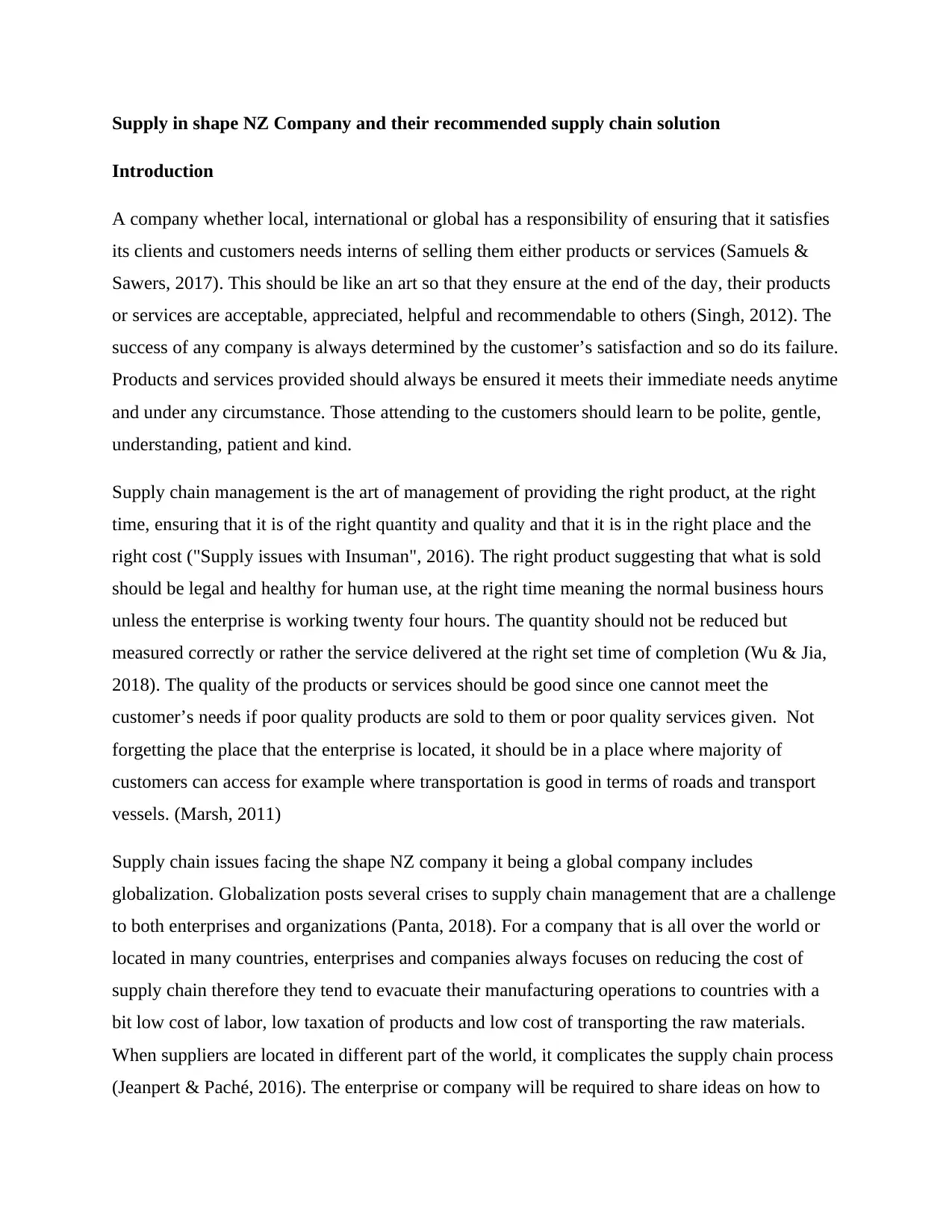
Supply in shape NZ Company and their recommended supply chain solution
Introduction
A company whether local, international or global has a responsibility of ensuring that it satisfies
its clients and customers needs interns of selling them either products or services (Samuels &
Sawers, 2017). This should be like an art so that they ensure at the end of the day, their products
or services are acceptable, appreciated, helpful and recommendable to others (Singh, 2012). The
success of any company is always determined by the customer’s satisfaction and so do its failure.
Products and services provided should always be ensured it meets their immediate needs anytime
and under any circumstance. Those attending to the customers should learn to be polite, gentle,
understanding, patient and kind.
Supply chain management is the art of management of providing the right product, at the right
time, ensuring that it is of the right quantity and quality and that it is in the right place and the
right cost ("Supply issues with Insuman", 2016). The right product suggesting that what is sold
should be legal and healthy for human use, at the right time meaning the normal business hours
unless the enterprise is working twenty four hours. The quantity should not be reduced but
measured correctly or rather the service delivered at the right set time of completion (Wu & Jia,
2018). The quality of the products or services should be good since one cannot meet the
customer’s needs if poor quality products are sold to them or poor quality services given. Not
forgetting the place that the enterprise is located, it should be in a place where majority of
customers can access for example where transportation is good in terms of roads and transport
vessels. (Marsh, 2011)
Supply chain issues facing the shape NZ company it being a global company includes
globalization. Globalization posts several crises to supply chain management that are a challenge
to both enterprises and organizations (Panta, 2018). For a company that is all over the world or
located in many countries, enterprises and companies always focuses on reducing the cost of
supply chain therefore they tend to evacuate their manufacturing operations to countries with a
bit low cost of labor, low taxation of products and low cost of transporting the raw materials.
When suppliers are located in different part of the world, it complicates the supply chain process
(Jeanpert & Paché, 2016). The enterprise or company will be required to share ideas on how to
Introduction
A company whether local, international or global has a responsibility of ensuring that it satisfies
its clients and customers needs interns of selling them either products or services (Samuels &
Sawers, 2017). This should be like an art so that they ensure at the end of the day, their products
or services are acceptable, appreciated, helpful and recommendable to others (Singh, 2012). The
success of any company is always determined by the customer’s satisfaction and so do its failure.
Products and services provided should always be ensured it meets their immediate needs anytime
and under any circumstance. Those attending to the customers should learn to be polite, gentle,
understanding, patient and kind.
Supply chain management is the art of management of providing the right product, at the right
time, ensuring that it is of the right quantity and quality and that it is in the right place and the
right cost ("Supply issues with Insuman", 2016). The right product suggesting that what is sold
should be legal and healthy for human use, at the right time meaning the normal business hours
unless the enterprise is working twenty four hours. The quantity should not be reduced but
measured correctly or rather the service delivered at the right set time of completion (Wu & Jia,
2018). The quality of the products or services should be good since one cannot meet the
customer’s needs if poor quality products are sold to them or poor quality services given. Not
forgetting the place that the enterprise is located, it should be in a place where majority of
customers can access for example where transportation is good in terms of roads and transport
vessels. (Marsh, 2011)
Supply chain issues facing the shape NZ company it being a global company includes
globalization. Globalization posts several crises to supply chain management that are a challenge
to both enterprises and organizations (Panta, 2018). For a company that is all over the world or
located in many countries, enterprises and companies always focuses on reducing the cost of
supply chain therefore they tend to evacuate their manufacturing operations to countries with a
bit low cost of labor, low taxation of products and low cost of transporting the raw materials.
When suppliers are located in different part of the world, it complicates the supply chain process
(Jeanpert & Paché, 2016). The enterprise or company will be required to share ideas on how to
Paraphrase This Document
Need a fresh take? Get an instant paraphrase of this document with our AI Paraphraser
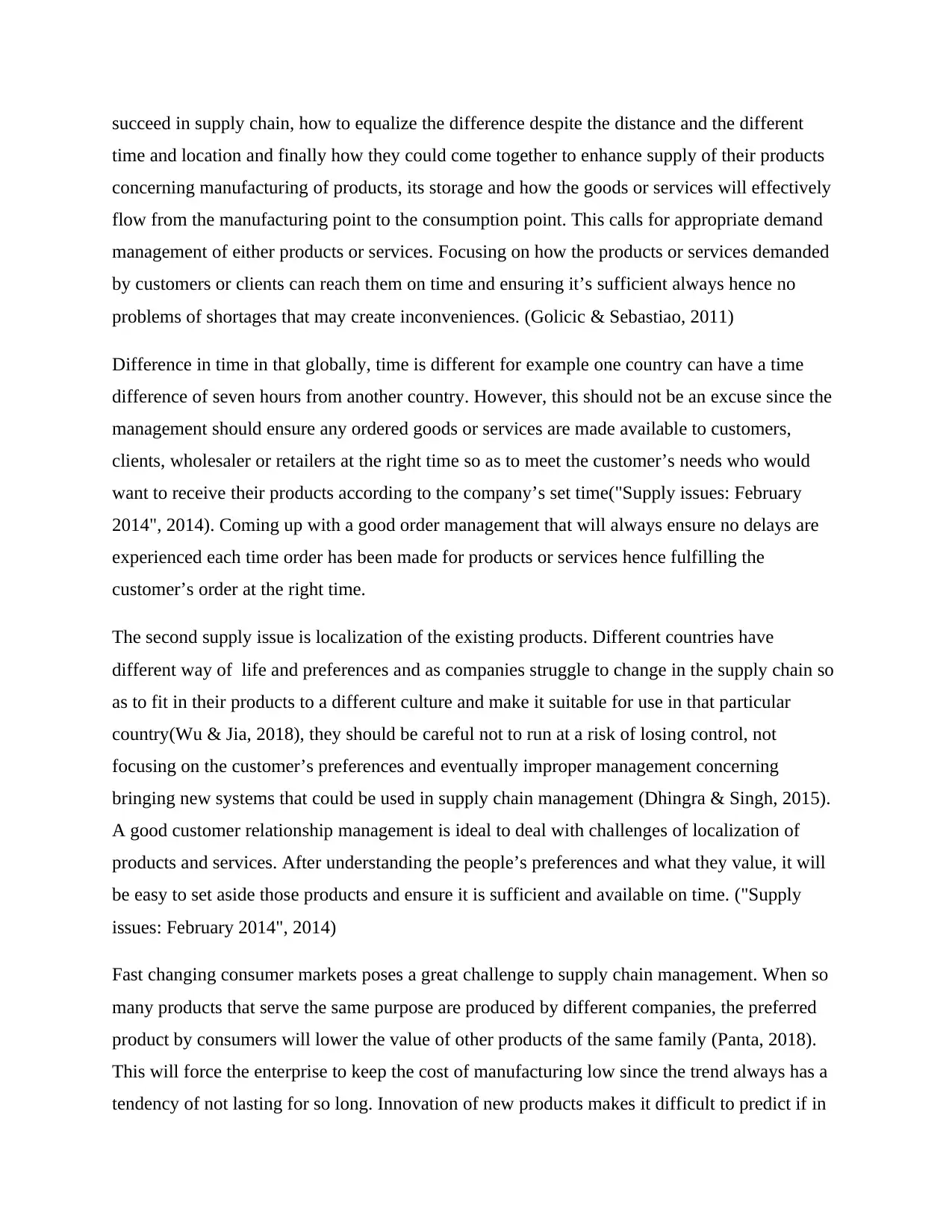
succeed in supply chain, how to equalize the difference despite the distance and the different
time and location and finally how they could come together to enhance supply of their products
concerning manufacturing of products, its storage and how the goods or services will effectively
flow from the manufacturing point to the consumption point. This calls for appropriate demand
management of either products or services. Focusing on how the products or services demanded
by customers or clients can reach them on time and ensuring it’s sufficient always hence no
problems of shortages that may create inconveniences. (Golicic & Sebastiao, 2011)
Difference in time in that globally, time is different for example one country can have a time
difference of seven hours from another country. However, this should not be an excuse since the
management should ensure any ordered goods or services are made available to customers,
clients, wholesaler or retailers at the right time so as to meet the customer’s needs who would
want to receive their products according to the company’s set time("Supply issues: February
2014", 2014). Coming up with a good order management that will always ensure no delays are
experienced each time order has been made for products or services hence fulfilling the
customer’s order at the right time.
The second supply issue is localization of the existing products. Different countries have
different way of life and preferences and as companies struggle to change in the supply chain so
as to fit in their products to a different culture and make it suitable for use in that particular
country(Wu & Jia, 2018), they should be careful not to run at a risk of losing control, not
focusing on the customer’s preferences and eventually improper management concerning
bringing new systems that could be used in supply chain management (Dhingra & Singh, 2015).
A good customer relationship management is ideal to deal with challenges of localization of
products and services. After understanding the people’s preferences and what they value, it will
be easy to set aside those products and ensure it is sufficient and available on time. ("Supply
issues: February 2014", 2014)
Fast changing consumer markets poses a great challenge to supply chain management. When so
many products that serve the same purpose are produced by different companies, the preferred
product by consumers will lower the value of other products of the same family (Panta, 2018).
This will force the enterprise to keep the cost of manufacturing low since the trend always has a
tendency of not lasting for so long. Innovation of new products makes it difficult to predict if in
time and location and finally how they could come together to enhance supply of their products
concerning manufacturing of products, its storage and how the goods or services will effectively
flow from the manufacturing point to the consumption point. This calls for appropriate demand
management of either products or services. Focusing on how the products or services demanded
by customers or clients can reach them on time and ensuring it’s sufficient always hence no
problems of shortages that may create inconveniences. (Golicic & Sebastiao, 2011)
Difference in time in that globally, time is different for example one country can have a time
difference of seven hours from another country. However, this should not be an excuse since the
management should ensure any ordered goods or services are made available to customers,
clients, wholesaler or retailers at the right time so as to meet the customer’s needs who would
want to receive their products according to the company’s set time("Supply issues: February
2014", 2014). Coming up with a good order management that will always ensure no delays are
experienced each time order has been made for products or services hence fulfilling the
customer’s order at the right time.
The second supply issue is localization of the existing products. Different countries have
different way of life and preferences and as companies struggle to change in the supply chain so
as to fit in their products to a different culture and make it suitable for use in that particular
country(Wu & Jia, 2018), they should be careful not to run at a risk of losing control, not
focusing on the customer’s preferences and eventually improper management concerning
bringing new systems that could be used in supply chain management (Dhingra & Singh, 2015).
A good customer relationship management is ideal to deal with challenges of localization of
products and services. After understanding the people’s preferences and what they value, it will
be easy to set aside those products and ensure it is sufficient and available on time. ("Supply
issues: February 2014", 2014)
Fast changing consumer markets poses a great challenge to supply chain management. When so
many products that serve the same purpose are produced by different companies, the preferred
product by consumers will lower the value of other products of the same family (Panta, 2018).
This will force the enterprise to keep the cost of manufacturing low since the trend always has a
tendency of not lasting for so long. Innovation of new products makes it difficult to predict if in
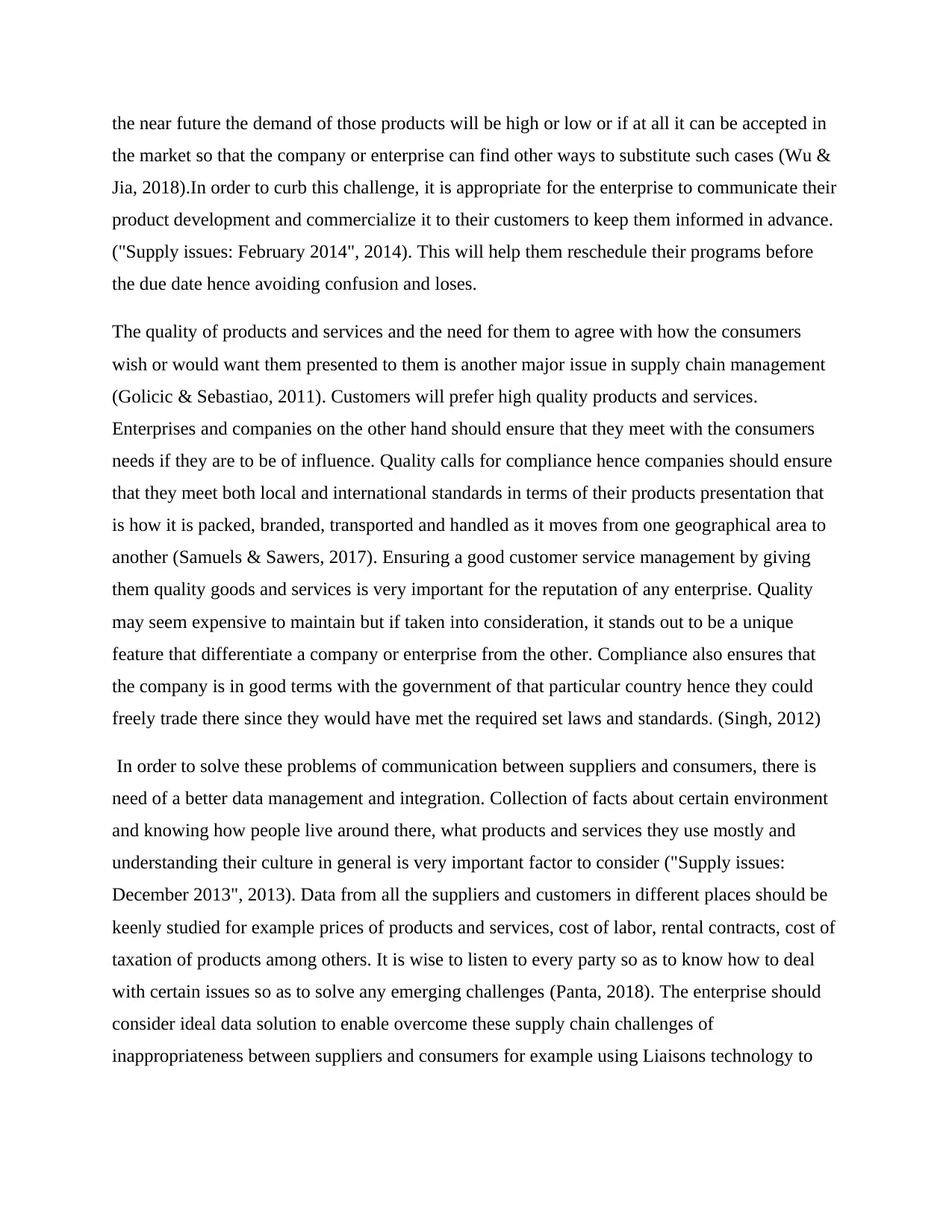
the near future the demand of those products will be high or low or if at all it can be accepted in
the market so that the company or enterprise can find other ways to substitute such cases (Wu &
Jia, 2018).In order to curb this challenge, it is appropriate for the enterprise to communicate their
product development and commercialize it to their customers to keep them informed in advance.
("Supply issues: February 2014", 2014). This will help them reschedule their programs before
the due date hence avoiding confusion and loses.
The quality of products and services and the need for them to agree with how the consumers
wish or would want them presented to them is another major issue in supply chain management
(Golicic & Sebastiao, 2011). Customers will prefer high quality products and services.
Enterprises and companies on the other hand should ensure that they meet with the consumers
needs if they are to be of influence. Quality calls for compliance hence companies should ensure
that they meet both local and international standards in terms of their products presentation that
is how it is packed, branded, transported and handled as it moves from one geographical area to
another (Samuels & Sawers, 2017). Ensuring a good customer service management by giving
them quality goods and services is very important for the reputation of any enterprise. Quality
may seem expensive to maintain but if taken into consideration, it stands out to be a unique
feature that differentiate a company or enterprise from the other. Compliance also ensures that
the company is in good terms with the government of that particular country hence they could
freely trade there since they would have met the required set laws and standards. (Singh, 2012)
In order to solve these problems of communication between suppliers and consumers, there is
need of a better data management and integration. Collection of facts about certain environment
and knowing how people live around there, what products and services they use mostly and
understanding their culture in general is very important factor to consider ("Supply issues:
December 2013", 2013). Data from all the suppliers and customers in different places should be
keenly studied for example prices of products and services, cost of labor, rental contracts, cost of
taxation of products among others. It is wise to listen to every party so as to know how to deal
with certain issues so as to solve any emerging challenges (Panta, 2018). The enterprise should
consider ideal data solution to enable overcome these supply chain challenges of
inappropriateness between suppliers and consumers for example using Liaisons technology to
the market so that the company or enterprise can find other ways to substitute such cases (Wu &
Jia, 2018).In order to curb this challenge, it is appropriate for the enterprise to communicate their
product development and commercialize it to their customers to keep them informed in advance.
("Supply issues: February 2014", 2014). This will help them reschedule their programs before
the due date hence avoiding confusion and loses.
The quality of products and services and the need for them to agree with how the consumers
wish or would want them presented to them is another major issue in supply chain management
(Golicic & Sebastiao, 2011). Customers will prefer high quality products and services.
Enterprises and companies on the other hand should ensure that they meet with the consumers
needs if they are to be of influence. Quality calls for compliance hence companies should ensure
that they meet both local and international standards in terms of their products presentation that
is how it is packed, branded, transported and handled as it moves from one geographical area to
another (Samuels & Sawers, 2017). Ensuring a good customer service management by giving
them quality goods and services is very important for the reputation of any enterprise. Quality
may seem expensive to maintain but if taken into consideration, it stands out to be a unique
feature that differentiate a company or enterprise from the other. Compliance also ensures that
the company is in good terms with the government of that particular country hence they could
freely trade there since they would have met the required set laws and standards. (Singh, 2012)
In order to solve these problems of communication between suppliers and consumers, there is
need of a better data management and integration. Collection of facts about certain environment
and knowing how people live around there, what products and services they use mostly and
understanding their culture in general is very important factor to consider ("Supply issues:
December 2013", 2013). Data from all the suppliers and customers in different places should be
keenly studied for example prices of products and services, cost of labor, rental contracts, cost of
taxation of products among others. It is wise to listen to every party so as to know how to deal
with certain issues so as to solve any emerging challenges (Panta, 2018). The enterprise should
consider ideal data solution to enable overcome these supply chain challenges of
inappropriateness between suppliers and consumers for example using Liaisons technology to
You're viewing a preview
Unlock full access by subscribing today!
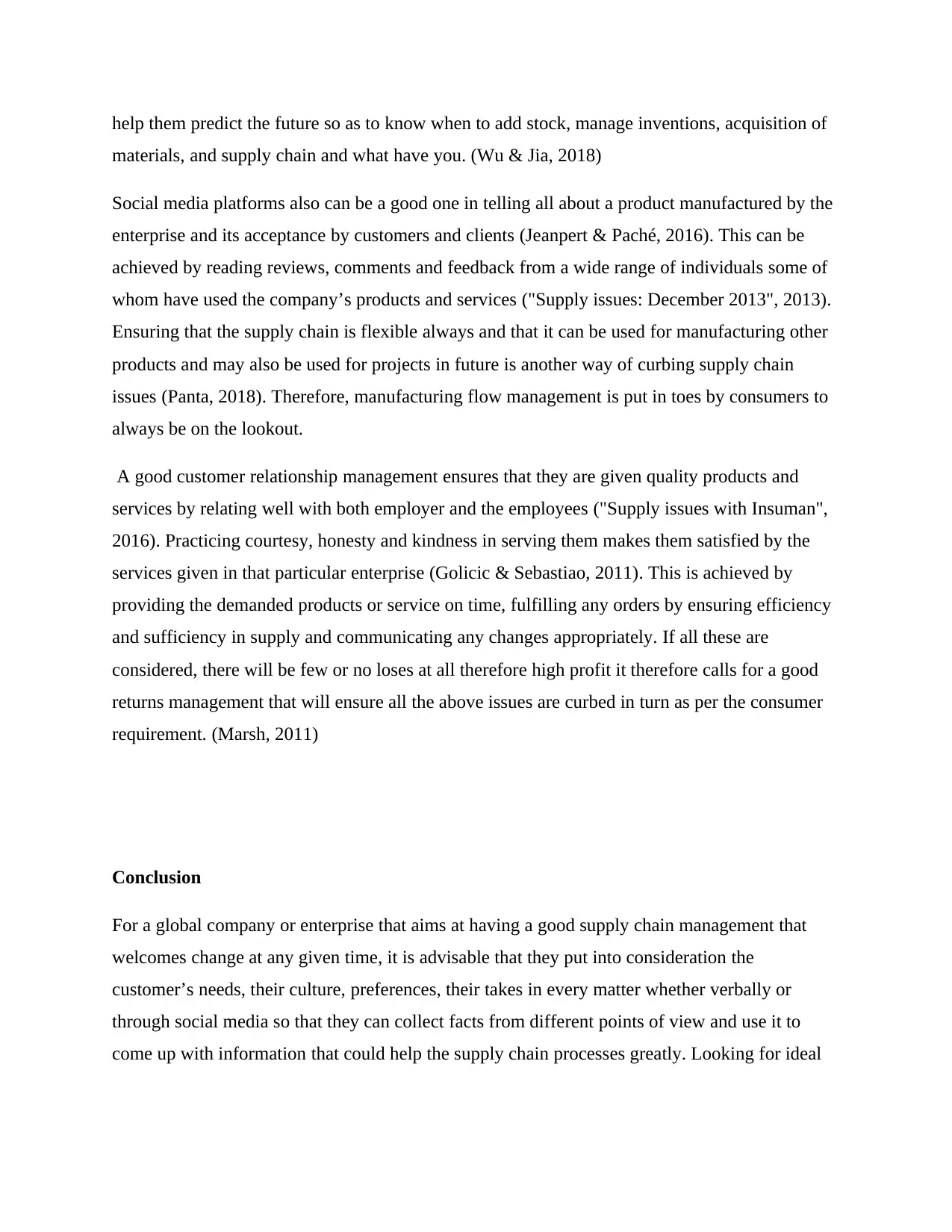
help them predict the future so as to know when to add stock, manage inventions, acquisition of
materials, and supply chain and what have you. (Wu & Jia, 2018)
Social media platforms also can be a good one in telling all about a product manufactured by the
enterprise and its acceptance by customers and clients (Jeanpert & Paché, 2016). This can be
achieved by reading reviews, comments and feedback from a wide range of individuals some of
whom have used the company’s products and services ("Supply issues: December 2013", 2013).
Ensuring that the supply chain is flexible always and that it can be used for manufacturing other
products and may also be used for projects in future is another way of curbing supply chain
issues (Panta, 2018). Therefore, manufacturing flow management is put in toes by consumers to
always be on the lookout.
A good customer relationship management ensures that they are given quality products and
services by relating well with both employer and the employees ("Supply issues with Insuman",
2016). Practicing courtesy, honesty and kindness in serving them makes them satisfied by the
services given in that particular enterprise (Golicic & Sebastiao, 2011). This is achieved by
providing the demanded products or service on time, fulfilling any orders by ensuring efficiency
and sufficiency in supply and communicating any changes appropriately. If all these are
considered, there will be few or no loses at all therefore high profit it therefore calls for a good
returns management that will ensure all the above issues are curbed in turn as per the consumer
requirement. (Marsh, 2011)
Conclusion
For a global company or enterprise that aims at having a good supply chain management that
welcomes change at any given time, it is advisable that they put into consideration the
customer’s needs, their culture, preferences, their takes in every matter whether verbally or
through social media so that they can collect facts from different points of view and use it to
come up with information that could help the supply chain processes greatly. Looking for ideal
materials, and supply chain and what have you. (Wu & Jia, 2018)
Social media platforms also can be a good one in telling all about a product manufactured by the
enterprise and its acceptance by customers and clients (Jeanpert & Paché, 2016). This can be
achieved by reading reviews, comments and feedback from a wide range of individuals some of
whom have used the company’s products and services ("Supply issues: December 2013", 2013).
Ensuring that the supply chain is flexible always and that it can be used for manufacturing other
products and may also be used for projects in future is another way of curbing supply chain
issues (Panta, 2018). Therefore, manufacturing flow management is put in toes by consumers to
always be on the lookout.
A good customer relationship management ensures that they are given quality products and
services by relating well with both employer and the employees ("Supply issues with Insuman",
2016). Practicing courtesy, honesty and kindness in serving them makes them satisfied by the
services given in that particular enterprise (Golicic & Sebastiao, 2011). This is achieved by
providing the demanded products or service on time, fulfilling any orders by ensuring efficiency
and sufficiency in supply and communicating any changes appropriately. If all these are
considered, there will be few or no loses at all therefore high profit it therefore calls for a good
returns management that will ensure all the above issues are curbed in turn as per the consumer
requirement. (Marsh, 2011)
Conclusion
For a global company or enterprise that aims at having a good supply chain management that
welcomes change at any given time, it is advisable that they put into consideration the
customer’s needs, their culture, preferences, their takes in every matter whether verbally or
through social media so that they can collect facts from different points of view and use it to
come up with information that could help the supply chain processes greatly. Looking for ideal
Paraphrase This Document
Need a fresh take? Get an instant paraphrase of this document with our AI Paraphraser
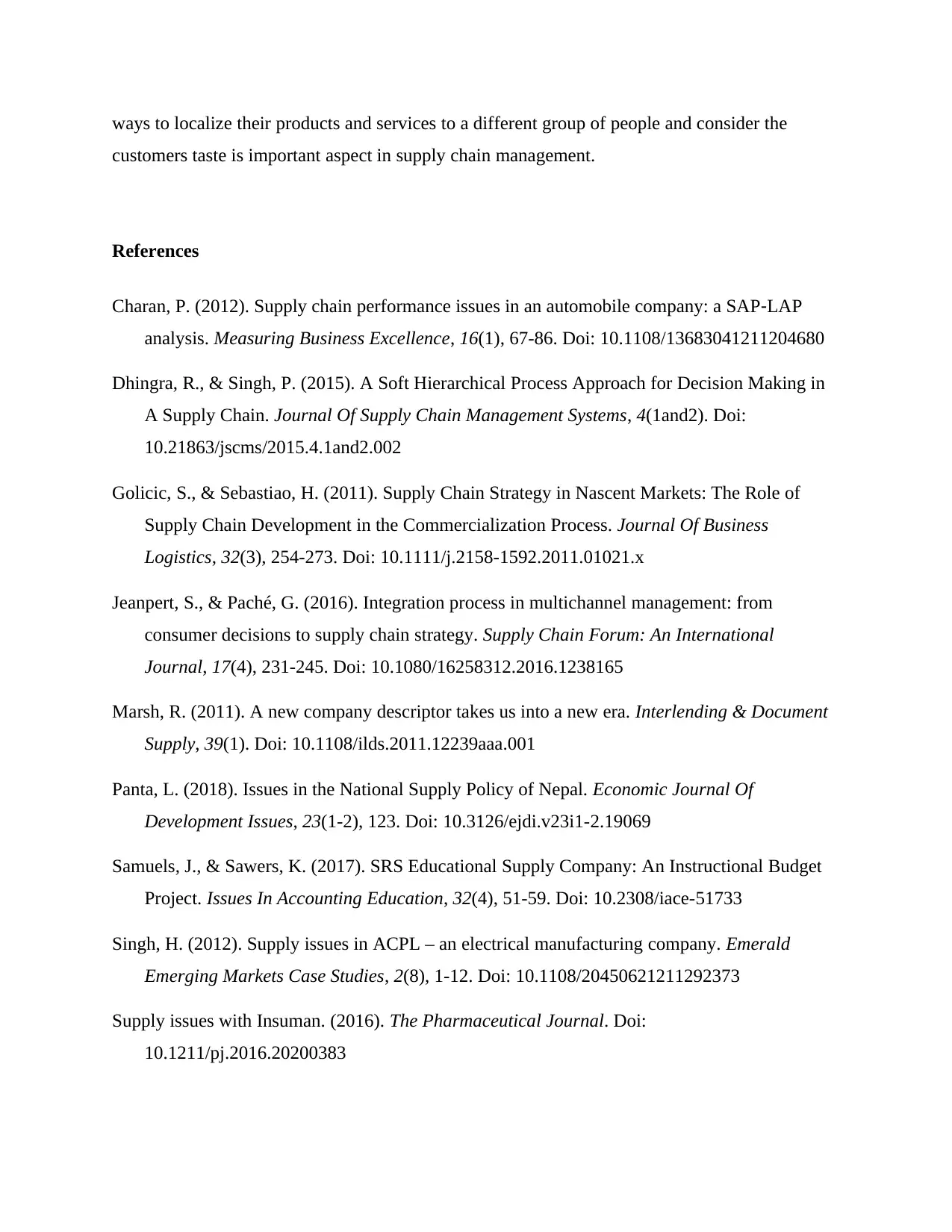
ways to localize their products and services to a different group of people and consider the
customers taste is important aspect in supply chain management.
References
Charan, P. (2012). Supply chain performance issues in an automobile company: a SAP‐LAP
analysis. Measuring Business Excellence, 16(1), 67-86. Doi: 10.1108/13683041211204680
Dhingra, R., & Singh, P. (2015). A Soft Hierarchical Process Approach for Decision Making in
A Supply Chain. Journal Of Supply Chain Management Systems, 4(1and2). Doi:
10.21863/jscms/2015.4.1and2.002
Golicic, S., & Sebastiao, H. (2011). Supply Chain Strategy in Nascent Markets: The Role of
Supply Chain Development in the Commercialization Process. Journal Of Business
Logistics, 32(3), 254-273. Doi: 10.1111/j.2158-1592.2011.01021.x
Jeanpert, S., & Paché, G. (2016). Integration process in multichannel management: from
consumer decisions to supply chain strategy. Supply Chain Forum: An International
Journal, 17(4), 231-245. Doi: 10.1080/16258312.2016.1238165
Marsh, R. (2011). A new company descriptor takes us into a new era. Interlending & Document
Supply, 39(1). Doi: 10.1108/ilds.2011.12239aaa.001
Panta, L. (2018). Issues in the National Supply Policy of Nepal. Economic Journal Of
Development Issues, 23(1-2), 123. Doi: 10.3126/ejdi.v23i1-2.19069
Samuels, J., & Sawers, K. (2017). SRS Educational Supply Company: An Instructional Budget
Project. Issues In Accounting Education, 32(4), 51-59. Doi: 10.2308/iace-51733
Singh, H. (2012). Supply issues in ACPL – an electrical manufacturing company. Emerald
Emerging Markets Case Studies, 2(8), 1-12. Doi: 10.1108/20450621211292373
Supply issues with Insuman. (2016). The Pharmaceutical Journal. Doi:
10.1211/pj.2016.20200383
customers taste is important aspect in supply chain management.
References
Charan, P. (2012). Supply chain performance issues in an automobile company: a SAP‐LAP
analysis. Measuring Business Excellence, 16(1), 67-86. Doi: 10.1108/13683041211204680
Dhingra, R., & Singh, P. (2015). A Soft Hierarchical Process Approach for Decision Making in
A Supply Chain. Journal Of Supply Chain Management Systems, 4(1and2). Doi:
10.21863/jscms/2015.4.1and2.002
Golicic, S., & Sebastiao, H. (2011). Supply Chain Strategy in Nascent Markets: The Role of
Supply Chain Development in the Commercialization Process. Journal Of Business
Logistics, 32(3), 254-273. Doi: 10.1111/j.2158-1592.2011.01021.x
Jeanpert, S., & Paché, G. (2016). Integration process in multichannel management: from
consumer decisions to supply chain strategy. Supply Chain Forum: An International
Journal, 17(4), 231-245. Doi: 10.1080/16258312.2016.1238165
Marsh, R. (2011). A new company descriptor takes us into a new era. Interlending & Document
Supply, 39(1). Doi: 10.1108/ilds.2011.12239aaa.001
Panta, L. (2018). Issues in the National Supply Policy of Nepal. Economic Journal Of
Development Issues, 23(1-2), 123. Doi: 10.3126/ejdi.v23i1-2.19069
Samuels, J., & Sawers, K. (2017). SRS Educational Supply Company: An Instructional Budget
Project. Issues In Accounting Education, 32(4), 51-59. Doi: 10.2308/iace-51733
Singh, H. (2012). Supply issues in ACPL – an electrical manufacturing company. Emerald
Emerging Markets Case Studies, 2(8), 1-12. Doi: 10.1108/20450621211292373
Supply issues with Insuman. (2016). The Pharmaceutical Journal. Doi:
10.1211/pj.2016.20200383
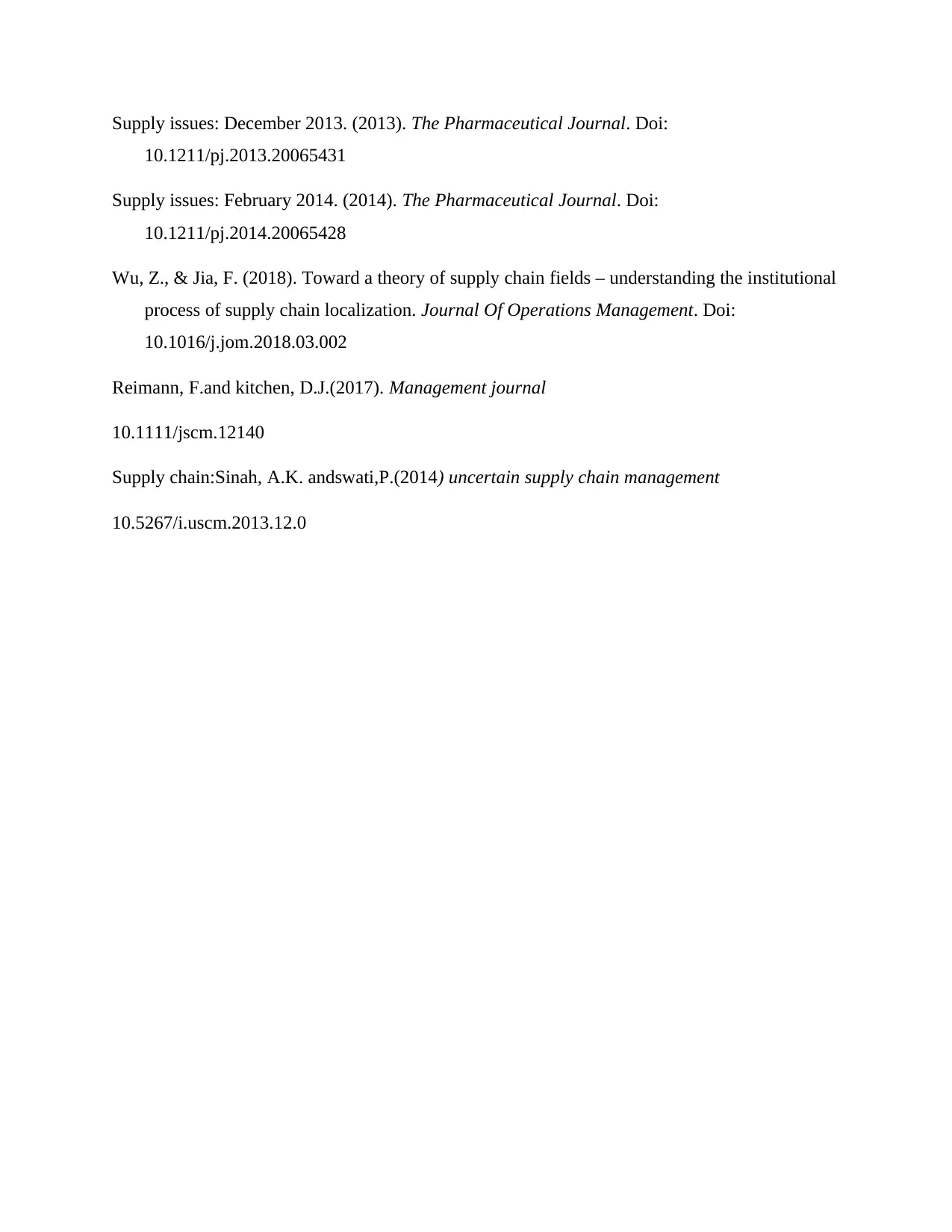
Supply issues: December 2013. (2013). The Pharmaceutical Journal. Doi:
10.1211/pj.2013.20065431
Supply issues: February 2014. (2014). The Pharmaceutical Journal. Doi:
10.1211/pj.2014.20065428
Wu, Z., & Jia, F. (2018). Toward a theory of supply chain fields – understanding the institutional
process of supply chain localization. Journal Of Operations Management. Doi:
10.1016/j.jom.2018.03.002
Reimann, F.and kitchen, D.J.(2017). Management journal
10.1111/jscm.12140
Supply chain:Sinah, A.K. andswati,P.(2014) uncertain supply chain management
10.5267/i.uscm.2013.12.0
10.1211/pj.2013.20065431
Supply issues: February 2014. (2014). The Pharmaceutical Journal. Doi:
10.1211/pj.2014.20065428
Wu, Z., & Jia, F. (2018). Toward a theory of supply chain fields – understanding the institutional
process of supply chain localization. Journal Of Operations Management. Doi:
10.1016/j.jom.2018.03.002
Reimann, F.and kitchen, D.J.(2017). Management journal
10.1111/jscm.12140
Supply chain:Sinah, A.K. andswati,P.(2014) uncertain supply chain management
10.5267/i.uscm.2013.12.0
You're viewing a preview
Unlock full access by subscribing today!
1 out of 6
Related Documents
Your All-in-One AI-Powered Toolkit for Academic Success.
+13062052269
info@desklib.com
Available 24*7 on WhatsApp / Email
![[object Object]](/_next/static/media/star-bottom.7253800d.svg)
Unlock your academic potential
© 2024 | Zucol Services PVT LTD | All rights reserved.





